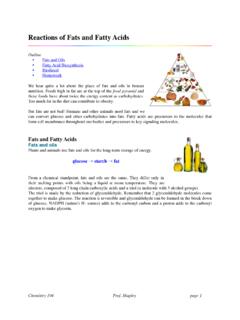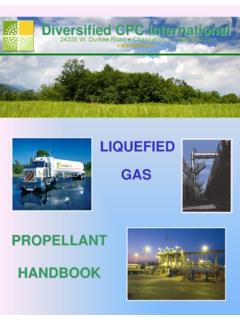Transcription of Biodiesel vs Renewable Final - Advanced BioFuels USA
1 What s the Difference between Biodiesel and Renewable (Green) Diesel by Jesse Jin Yoon for Advanced BioFuels USA With the intensifying search for a sufficient alternative to oil-based energy, the development of alternative energy sources becomes increasingly relevant. Fuels derived from biomass or biological sources have received much attention. Among the various alternative fuel options, Biodiesel and Renewable diesel have been gaining traction in popularity. Although both fuels can be derived from biomass, they are two distinctly different fuels. The purpose of this paper is to define both fuels and provide a general comparison between the two fuels. DEFINITIONS Petroleum diesel (Petrodiesel) Before addressing the comparison between Biodiesel and Renewable diesel, it is important to first define petrodiesel, more commonly known as diesel fuel or simply diesel.
2 Diesel fuel is a petroleum distillate rich in paraffinic hydrocarbons. Petrodiesel is produced from fractional distillation of crude oil between 200C (392F) and 350C (662F) at atmospheric pressure, resulting in a mixture of carbon chains that typically contain between 8 and 21 carbon atoms per molecule. [1] Petrodiesel falls under the specifications outlined by ASTM D975 in the United States and EN 590 in Europe. The distillation process of crude oil into its fractions, including diesel, is depicted below in Figure 1. Figure 1. Crude oil is separated into fractions by fractional distillation. The fractions at the top of the fractionating column have lower boiling points than the fractions at the bottom. The heavy bottom fractions are often cracked into lighter, more useful products. All of the fractions are processed further in other refining units.
3 [2] Biodiesel Biodiesel is produced using a transesterification process, reacting vegetable oils or animal fats catalytically with a short-chained aliphatic alcohol (typically methanol or ethanol). Glycerol is a by-product of this transesterification process. [3] Biodiesel is defined under the standard of ASTM D6751 as a fuel comprised of mono-alkyl esters of long-chain fatty acids derived from vegetable oils or animal fats. Biodiesel is also referred to as FAME (fatty acid methyl ester) or RME (rape seed methyl ester) in Europe. Figure 2 Figure 2. Transesterification of triglycerides from animal fats or plant oil (1) with methanol (2) to yield Biodiesel (3) and glycerol (4). [3] Biodiesel is chemically different from petrodiesel and Renewable diesel because it contains oxygen atoms (note the O in the Biodiesel (3) structure above).
4 This leads to different physical properties for Biodiesel . [13] Biodiesel is created using a large variety of feed stocks. [4] Virgin oil feedstock; rapeseed and soybean oils are most commonly used, soybean oil alone accounting for about ninety percent of all fuel stocks in the US. It also can be obtained from field pennycress and jatropha and other crops such as mustard, flax, sunflower, palm oil, coconut, and hemp. Waste vegetable oil (WVO); Animal fats including tallow, lard, yellow grease, chicken fat, and the by-products of the production of Omega-3 fatty acids from fish oil. Algae, which can be grown using waste materials such as sewage and without displacing land currently used for food production. Oil from halophytes such as salicornia bigelovii Biodiesel can be used in its pure form, or blended with petrodiesel as an additive.
5 Biodiesel in its pure form is designated B100 where the 100 refers to 100% Biodiesel . Biodiesels blended with petrodiesel follow a similar nomenclature. For instance, a blended fuel comprised of 20% Biodiesel and 80% petrodiesel is called B20. Renewable (Green) Diesel Renewable Diesel, often called green diesel or second generation diesel, refers to petrodiesel-like fuels derived from biological sources that are chemically not esters and thus distinct from Biodiesel . Renewable diesel is chemically the same as petrodiesel, but it is made of recently living biomass. [5] The definition of Renewable diesel is not as straight forward as that of Biodiesel . The term Renewable diesel has been defined separately by the Department of Energy (DOE) with the Internal Revenue Service (IRS) and the Environmental Protection Agency (EPA).
6 The specifics of the definitions can be found in the appendix. [6] In addition, the terms Renewable diesel and green diesel have been further distinguished based on the processing method to create the fuel with petrodiesel-like chemical composition. A brief description of this can be found in the appendix. [7] For the purpose of this discussion, the term Renewable diesel will refer to all diesel fuels derived from biomass that meet the standards of ASTM D975 and are not mono-alkyl esters. There are three primary methods for creating Renewable diesel, hydrotreating, thermal conversion, and Biomass-to- liquid . [8] Renewable diesel can be made from the same feed stocks as Biodiesel since both require the tricylglycerol containing material from biomass. Renewable diesel blends follow the same nomenclature as Biodiesel .
7 Renewable diesel in its pure form is designated R100 while a blend comprised of 20% Renewable diesel and 80% petrodiesel is called R20. Because Renewable diesel is chemically the same as petrodiesel, it can be mixed with petrodiesel in any proportion but users may need to add an additive to address lubricity issue associated with compounds with no oxygen. FUEL PRODUCTION Biodiesel Transesterification Transesterification is a chemical process where an ester is reacted with an alcohol to form another ester and another alcohol. For the creation of Biodiesel , triglyceride oils (esters) are reacted with methanol (alcohol) to produce Biodiesel (fatty acid alkyl esters) and glycerin (alcohol). The process can be seen below in figure 3 where R1, R2, and R3 are long hydrocarbon chains, often called fatty acid chains.
8 [9] Figure 3 As shown in the diagram above (Figure 3), the triglyceride contains three separate ester functional groups and can react with three molecules of methanol to form three methyl esters (fatty esters) and glycerol (glyceride). The catalyst for this reaction is sodium hydroxide or another strong base such as potassium hydroxide. These hydroxides cause the methanol to dissociate and produce the methoxide ion, which is the actual catalytic agent that drives the reaction forward to create Biodiesel . Some feedstocks require a pretreatment reaction before they can go through the transesterification process. Feedstocks with more than 4% free fatty acids, which include inedible animal fats and recycled greases, must be pretreated in an acid esterification process. This process reacts the feedstock with an alcohol such as methanol in the presence of a strong acid catalyst such as sulfuric acid in order to convert the free fatty acids into Biodiesel .
9 The remaining trigylcerides are converted to Biodiesel using the transesterification process. The overall Biodiesel production process is outlined in Figure 4 below. [10] Biodiesel Production Process (Figure 4) Acid Esterification. Oil feedstocks containing more than 4% free fatty acids go through an acid esterification process to increase the yield of Biodiesel . These feedstocks are filtered and preprocessed to remove water and contaminants, and then fed to the acid esterification process. The catalyst, sulfuric acid, is dissolved in methanol and then mixed with the pretreated oil. The mixture is heated and stirred, and the free fatty acids are converted to Biodiesel . Once the reaction is complete, it is dewatered and then fed to the transesterification process. Transesterification.
10 Oil feedstocks containing less than 4% free fatty acids are filtered and preprocessed to remove water and contaminants and then fed directly to the transesterification process along with any products of the acid esterification process. The catalyst, potassium hydroxide, is dissolved in methanol and then mixed with and the pretreated oil. If an acid esterification process is used, then extra base catalyst must be added to neutralize the acid added in that step. Once the reaction is complete, the major co-products, Biodiesel and glycerin, are separated into two layers. Methanol recovery. The methanol is typically removed after the Biodiesel and glycerin have been separated, to prevent the reaction from reversing itself. The methanol is cleaned and recycled back to the beginning of the process.

